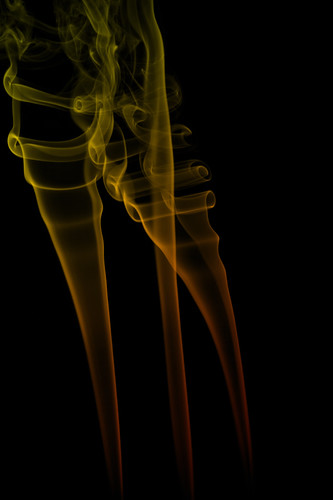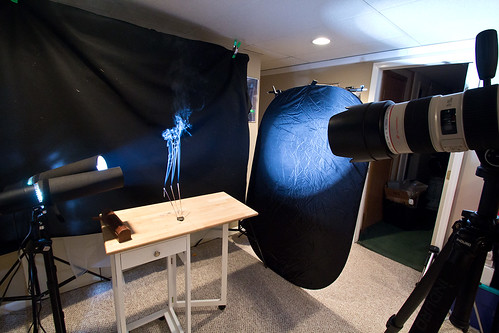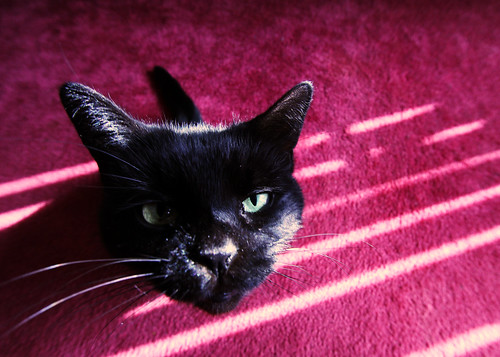I am an information junkie.
Before I purchased a film camera, I researched them, and found one that would be versatile enough to shoot "weird" films (Neither the EOS 650 nor EOS 620 use an infrared film counter, meaning they won't fog IR film).
Before I purchased film, I researched different developing chemicals. I learned the difference between C-41, E-6, and D-76 processes (Color Negative, Color Positive, and Black and White, respectively). I found the most common (but, not necessarily the best) Black and White developing chemicals are the Kodak chemicals, and their clones. Consequently, there was a ton of information I could study about using those chemicals in film developing.
Before I purchased the chemicals and the kit, I read about the process. What I read didn't seem too intimidating, aside from the few steps that need to be performed in total darkness, so, I practiced them as much as I could. There are numerous tips and tricks out there, and I read quite a few. I also dismissed one or two, but, I'll get into that.
Without any further ado, and, if you're interested, this is how I develop a roll of film. Your mileage may vary, don't try this at home, not responsible for trashed negatives, ruined images, or broken dreams. Void where prohibited by law or common sense.
My kit:
- A rounded-end bottle opener
- A pair of scissors
- A digital cooking thermometer with probe
- (3)
Rubbermaid Gallon Jugs- (4)
Quart Bottles- (1)
18-Quart Dish Tub- (1)
Paterson Universal Tank and Reel-
Kodak D76 Developer-
Kodak Indicator Stop Bath-
Kodak Fixer with Hardener-
Kodak Photo-flo-
Film Clips-
The Massive Dev Chart Mobile AppThis assumes you've mixed up the chemicals according to their directions. For the Developer, Stop Bath, and Fixer, I mix a gallon at a time in the Rubbermaid Gallon Jugs. The Photo-Flo gets mixed 500ml at a time in one of the quart bottles.
All the bottles are marked in multiple locations with a sharpie with their purpose (Developer (D), Stop Bath (S), Fixer (F), Photo-flo (R - for "rinse aid"))
Fill the 18-quart tub with 68-degree water. Put 500ml of each chemical in its respective quart-sized bottle. Making sure the caps are on tightly, put the bottles in the washtub full of water. Leave them in there until the contents of the bottles are at 68 degrees. Hint: Keeping your darkroom at 68 degrees makes this step quick and easy!
In my
tiny downstairs bathroom high-tech darkroom, I place a board across the utility sink, and line up the following items, in the following order from left to right:
Roll of film
Can opener
Scissors
Film reel
"Stem" for tank
Tank
Funnel for tank
Agitator rod for tank in the tank lid
Here's where it gets fun.
I put my mobile phone and any other potential light source outside the bathroom. I turn off the lights, close the door, and (if needed) block the bottom of the door with a towel.
Now, I wait. I give myself about two minutes in the pitch black to see if I can pick out any light sources. If I did, I'd fix them. Assuming all is good, then, I start in on the film.
Pop the end of the film roll without the stem off, using the can opener. I toss this in the shower stall. Pull the film out, and I wind it backwards until I get to the spool. Basically, this puts the leader all the way inside the roll of film.
Using the scissors, I cut the tape holding the film to the spool. Films are assembled differently. Tri-X has a nice taped design that makes cutting simple, and you should only have to cut the tape, not the film itself.
At this point, many, many tutorials will tell you to cut off the leader. This is one where I differ from conventional wisdom. I leave the leader on for easier handling later. I don't suspect developing the leader is causing any harm.
Now, I load the film onto the reel, starting with the last frame and working my way up to the leader. The new plastic reels with their ratcheting mechanism make this tremendously simple, but, practice is the key. Buy the cheapest roll you can find and practice loading it in the light before you take a swing at it in the dark. In particular, learn to listen to what it sounds like when the film starts to jam, and learn what it feels like as the film is loading properly (it'll move smoothly forward on the forward stroke, and should just lightly twitch once on the back stroke).
Then, I put the reel on the stem, put the stem in the tank, lock in the funnel (which in theory makes the tank light-tight) and insert the agitator rod.
Then I breathe. I can turn on the lights, wipe the sweat off my forehead, and chuckle nervously. Once that's done, the actual development process begins.
Grab the cell phone, and fire up the Massive Dev Chart mobile app. If you have an iPhone, and you develop film, spend the $7.00 and get this. You
will not regret the purchase. If you can't use the app, you'll need to have your times written down, and a stopwatch handy.
For Tri-X 400 in 500 ml of "stock" (i.e. Mixed according to Kodak's instructions) D76 at 20C, this is the "recipe" I use.
Developer
6:45
Agitate for the first 90 seconds, and then for 10 seconds at the top of each minute.
Dump the developer down the drain
Stop Bath
1:00
Constant Agitation
Pour the stop bath back into the 1-quart bottle
Fixer
5:00
Agitate for the first minute, and then for 10 seconds at the top of each minute.
Fixer goes down the drain
Photo-flo
2:00
Constant light agitation
Photo-flo goes down the drain
At this point, I'll pull the funnel and agitator rod out.
Rinsing
10:30
Periodic agitation / dump and refill the tank. Constant flow of clean water
Once that's done, I grab the leader (carefully) and (carefully) remove the film from the reel. Then I (carefully) punch the teeth on the unweighted film clip through the unprinted portion of the film with the tape on it. I unroll the film all the way (although, by this point, it's not too curled up), cut off the leader, and (carefully) put the weighted clip on the bottom of the film.
That's it. I'll let them dry for a few hours, then scan them.








